HOW CAN WE HELP YOU? Call 1-800-TRY-CHOP
In This Section
Our Most Read Stories of 2020 Highlight Hope, Inspiration, and Positive Moments

The stories that engaged our readers on social media in 2020 inspire us with hope for the future of children’s health.
limjr [at] email.chop.edu (By Jillian Rose Lim)
In a year marked by challenge and change, our most popular stories of 2020 send us straight into 2021 with hope in our hearts. As in previous years, we peeked into our Cornerstone data to see which stories shared on our social media channels resonated with readers the most. With engagement as our key parameter, it was no surprise that blog posts about COVID-19, the biggest healthcare headline of 2020, made the list. But beyond that, so did stories about the people and projects that stayed strong during and despite the pandemic. From an assistant director who creates space for foster children in her heart and home, to life-changing advancements in how we manage peanut allergies, to good news about the benefits of fetal surgery, these stories leave us thankful for our healthcare workers, scientists, and staff — the heroes who make the research engine rumble every day. And though the year was nothing like anyone expected, we wouldn’t have our Children’s Hospital of Philadelphia community any other way.
Breakthrough Immunotherapy Brings Hope for Patients Managing Peanut Allergies
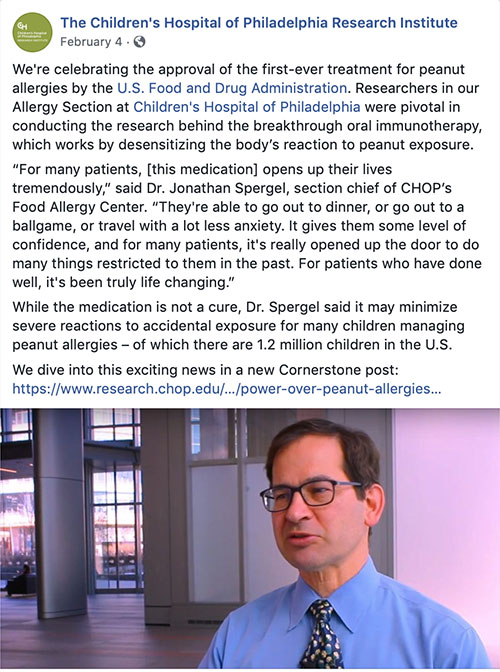
The FDA’s approval of an oral immunotherapy brought hope for children managing peanut allergies.
In February, the Food and Drug Administration (FDA) approved a first-of-its-kind oral immunotherapy to help manage peanut allergies in children, and our social media followers responded to the news with equal parts excitement and engagement. The approval came after more than a decade of research conducted in part by experts in our Allergy Program and signified a potentially life-changing step for patients, according to Jonathan Spergel, MD, PhD, section chief of CHOP’s Food Allergy Center.
“For many patients, [this medication] opens up their lives tremendously,” said Dr. Spergel, who led initial preclinical studies of the drug. “It gives them some level of confidence, and for many patients, it’s really opened up the door to do many things restricted to them in the past. For patients who have done well, it’s been truly life changing.”
In our Cornerstone coverage of the approval, Dr. Spergel delved into how the oral medication minimizes severe reactions to peanut exposure. Following a similar approach to allergy shots, patients receive small but increasing amounts of the allergen over time. Eventually, their reaction to an accidental peanut exposure may be milder since the immunotherapy is slowly desensitizing their body to the allergen. Our story resonated with readers on our Facebook and Twitter channels, many of whom shared, liked, and commented about this big step forward in allergy treatment.
Learn more about the oral immunotherapy advanced by our allergy experts.
CHOP Community Rallies Together To Tackle Sanitizer Shortage
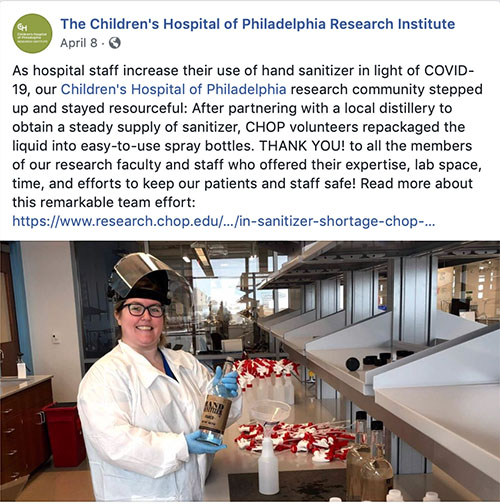
Volunteers across CHOP stepped up to address the sanitizer shortage during the COVID-19 pandemic.
One of the most popular Cornerstone stories of 2020 also happens to reflect our deep pride in the faculty and staff at the Research Institute. When the COVID-19 pandemic first hit, hospitals across the nation including CHOP faced a shortage of hand sanitizer — one of the key ingredients in keeping patients and staff protected from the coronavirus. Not wasting a moment, several groups across the Research Institute and hospital leveraged their collective expertise in safety, compliance, and quick-thinking, to address this need.
Our Cornerstone story chronicles the collaborative effort between individuals in CHOP’s Pharmacy Services, Supply Chain, Environmental Health and Safety, Infection Prevention, and many other groups. After procuring a sanitizer formula from local distillery, Faber Liquor, that was compliant with FDA and World Health Organization recommendations, volunteers then met weekly in our vacant lab spaces throughout April to measure out and package the sanitizer into handy spray bottles. This quote from Matthew Hodgson, vice president of Research Compliance and Regulatory Affairs, sums up the gratitude we feel for the individuals in our research community.
“People across the organization are being asked to find creative solutions to new problems — problems I don’t think we anticipated we’d ever face,” Hodgson said. “Before Supply Chain identified a distillery who could manufacture the hand sanitizer, we were exploring how the Research Institute could manufacture our own hand sanitizer! I have been impressed and humbled by the genuine interest of our employees to help in any way they are able to contribute.”
Get inspired by our collaborative, caring community.
Fetal Surgery Benefits Continue to Childhood for MMC Patients
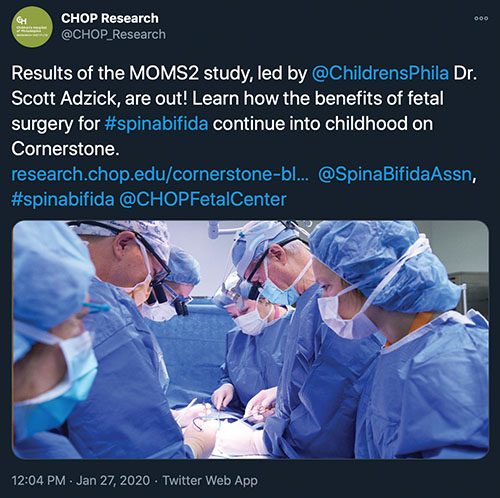
A new paper showed the benefits of fetal surgery for spinal bifida continued into childhood.
One story that captured the attention of our Twitter and Facebook readers captures all the moments of an inspirational tale, from hope, to challenges, to love. With the help of 6-year-old Audrey Rose, we shared how results from a Pediatrics story that reported significant physical and emotional benefits in school-age children who received corrective fetal surgery for myelomeningocele (MMC), the most severe form of spina bifida. The findings highlight the continued success of fetal surgery to repair spina bifida, an advancement pioneered by CHOP doctors like N. Scott Adzick, MD, MMM, CHOP Surgeon-in-Chief.
In our Cornerstone story, Dr. Adzick shared how findings from the “MOMS2: Follow-up of the Management of Myelomeningocele Study” add to the growing evidence of the benefits of prenatal surgery for spina bifida. The original MOMS study, which followed children for two and a half years after they received fetal surgery, had also revealed a number of benefits, including improved mobility, an increase in the likelihood of walking independently, and reducing the need for a shunt to divert fluid from the brain, as compared to babies who received surgery after birth.
Meanwhile, as CHOP’s 1,000th fetal surgery patient, Audrey Rose shared how she’s thriving years after her surgery in 2013. She has a love for ballet and a bucket list that includes riding a bike. “She’s completely independent,” said her mother. “I think that’s why she is so proud and fearless. She knows the important thing is to do it the Audrey way, whatever that looks like.”
Meet Audrey and learn how prenatal surgery changed her life.
Four-Legged Friends Help Build Evidence for a COVID-19 Breathalyzer
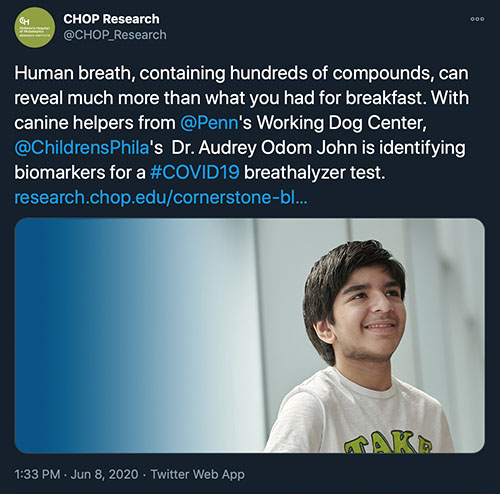
Infectious Disease experts at CHOP teamed up with canine collaborators to develop a “breathalyzer” for COVID-19.
Woof! Combine furry four-legged companions and fascinating science, and you’ve got a surefire formula for a popular story, as one of our most engaging stories on Twitter shows. In this Cornerstone blog, we looked at a collaboration between dogs at the Penn Vet Working Dog Center and CHOP researchers, as they worked toward developing a noninvasive method to detect COVID-19. With the help of the working dogs’ powerful sense of smell and a technique called mass spectrometry, a team led by Audrey Odom John, MD, PhD, chief of the Division of Infectious Diseases at CHOP, sought to identify the breath biomarkers needed to develop a “breathalyzer” test for COVID-19.
Dr. John had done similar research into malaria, wherein her team searched for the compounds produced by the malaria parasite. These compounds can function as biomarkers as they can indicate changes to a person’s clinical state. In the Breath, Urine, Saliva (BUS) study, Dr. John’s team planned to test the compounds they identified in the breath and urine of children with a SARS CoV-2 infection with the working dogs.
“The dogs either signal that they smell it, or they don’t,” Dr. John said. “They do the math much better, essentially. And while I think it's probably not what would ultimately be used as a diagnostic device in the clinic — much as I would like dogs in the clinic — I think what the dogs allow us to do is get to the answer the quickest.”
Read all about the canine collaboration.
Scientists Seek to Understand COVID-19 Cases in Children
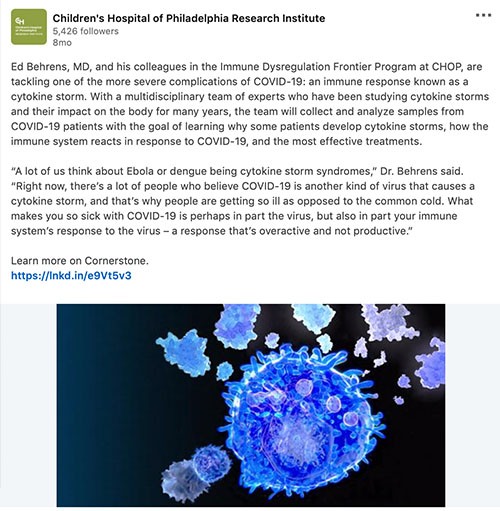
CHOP researchers explored whether cytokine storms played a role in severe COVID-19 cases in children.
When news of the COVID-19 pandemic hit earlier this year, our researchers raced to brainstorm new approaches for understanding the virus, drawing on their expertise. In May, we sat down with Edward Behrens, MD, chief of the Division of Rheumatology, to learn about how one phenomenon he has studied for most of his career, cytokine storms, may contribute to severe outcomes of COVID-19 in some children. The story gained much engagement and attention on our social media channels.
Cytokine storms occur when a person’s immune system responds overwhelmingly to infections or foreign invaders. Mistaking which cells to protect and which to attack in the body, the immune system flares out of control and can result in hyperinflammation, organ failure, or death. Because COVID-19 patients show moderately high levels of IL-6, similar to those with a type of cytokine storm called cytokine release syndrome , Dr. Behrens and colleagues in the Immune Dysregulation Frontier Program moved fast to develop a study where they could take a closer look at possible cytokine storms in COVID-19 cases. The multidisciplinary team collected biospecimens from pediatric patients who tested positive for the virus and hoped to answer a number of questions about why some patients’ immune systems respond differently than others.
“We're going to completely characterize the immune landscape of children infected with COVID-19 to understand what it is their immune systems are doing,” Dr. Behrens said. “So, we’ll look at the kind of antibody response children make. We’ll look at the cytokines they produce. And we’ll conduct tests that allow us to look at what each individual cell in the blood is doing at any moment in time.”
Dive into the science of cytokine storms.
Paulette McRae ‘Grants Grace’ by Providing a Welcoming Home for Foster Children
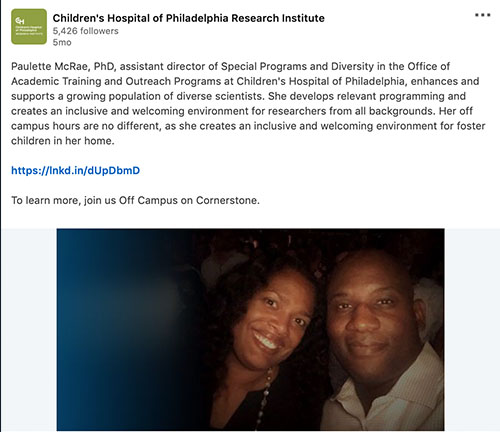
Off-duty, Paulette McRae provides children with a warm, happy home.
We’re not surprised that this heartwarming story, featuring Paulette McRae, assistant director of Special Programs and Diversity in the Office of Academic Training and Outreach Programs (ATOP), ranked as one of our most engaging stories shared on social media. Our “Off Campus” Cornerstone series is a seasonal set of stories and photos about Research Institute colleagues and what they do on their down time. In July, we featured Dr. McRae and her creation of an inclusive and happy home environment for foster children.
In the story, Dr. McRae describes how she and her husband, Terrence, came to the decision to become foster parents and how the experience has changed their lives, as well as those of the children they have given a home.
“To have children come into your home at such a pivotal point in their lives, to be able to walk with them during this period, to build a rapport with them, and to watch them grow, to develop, to soar — it’s amazing,” Dr. McRae said. “To see the world through their eyes and know that with all they’ve been through and all they’ve experienced, they still find joy, they still laugh, they still smile. They still enjoy life. That’s the most rewarding part of fostering.”
Since 2019, Dr. McRae and her husband have fostered a total of seven children, providing them with not just a safe place to grow, but also working to assess what each child needs and advocate for them when it comes to good health and successful schooling.
“We’ve learned to grant people grace,” Dr. McRae said. “I haven’t walked a day in mom’s shoes, but by going through this process, I’ve quickly learned that the way you look at situations is not the way everybody looks at them, so let’s not to be judgmental. We’re pulling for mom; we’re rooting for her. Ultimately, the goal will be for them to reunify with their mom. All we can do is pray that whatever we put in place will continue, and it will strengthen the family.”
We can’t think of a more hopeful story to send us into the new year.


